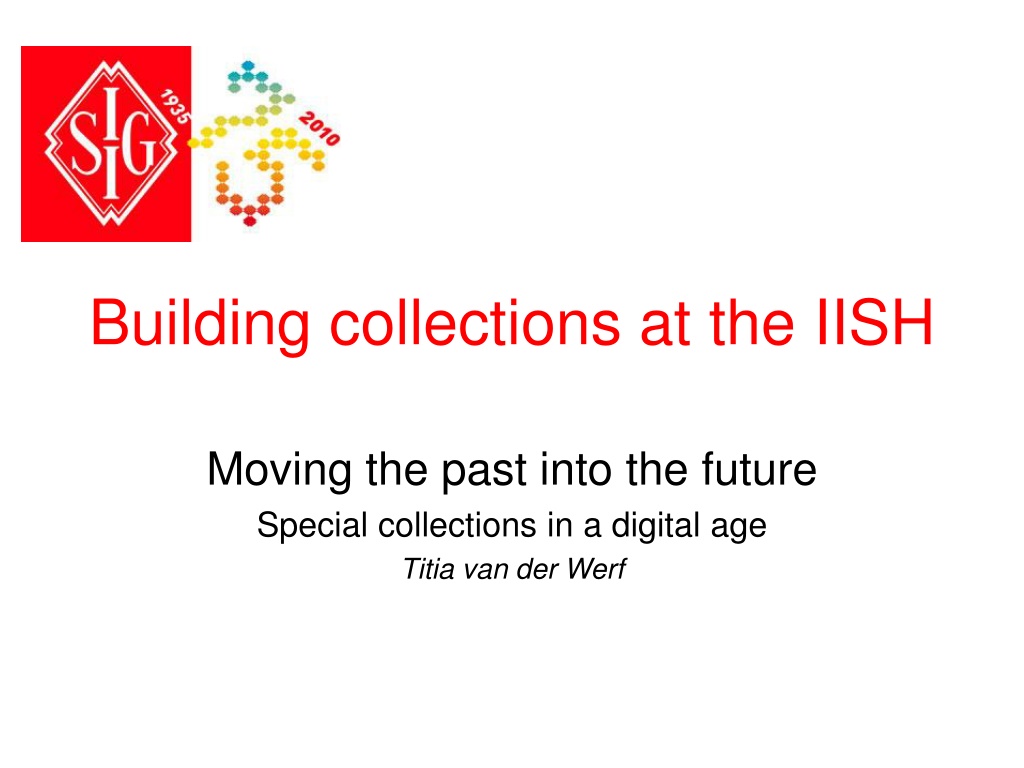Building Collections at IISH: Moving the Past into the Future
Explore the extensive collection building process at the International Institute of Social History, spanning from the organization's founding to its current rescue mission. Discover special collections covering diverse movements and historical events, showcasing a wealth of archives, books, visual items, audio recordings, films, and more providing a unique insight into social history.
Download Presentation

Please find below an Image/Link to download the presentation.
The content on the website is provided AS IS for your information and personal use only. It may not be sold, licensed, or shared on other websites without obtaining consent from the author. Download presentation by click this link. If you encounter any issues during the download, it is possible that the publisher has removed the file from their server.
E N D
Presentation Transcript
Building collections at the IISH Moving the past into the future Special collections in a digital age Titia van der Werf
CONTENT Collection characteristics Characteristics of the collection building process The organisation of collection building How to continue? Framing collection building in the research process Moving the past into the future
Collection characteristics The International Institute of Social History was founded in 1935 by Posthumus
Collection Statistics Total: 50 km >3000 archives >1 mln books >1 mln visual items >15.000 hours audio >1.100 hours film >6.500 hours video >20 TB digitised collections + born-digital photographs
Characteristics of the collection building process 1935-1940: saving material from all over Europe 1940-1955: war and recovery 1960-now: rescue mission still leading principle material from Latin America Turkish communist party, Kurdish movement Rights movements, the Karen Human Rights in Burma Papers of the Iranian diaspora, after the Islamic Revolution In the Netherlands: IISH is the de-facto memory institution for the Dutch Left (trade unions and political parties)
Characteristics of the collection building process Integrating collections Press museum: Dutch newspaper heritage AdvertisingArsenal: Dutch advertising heritage NEHA: Dutch economic and corporate heritage Library of the Dutch Academy of Sciences: History of science NIZA: Anti-apartheid movement
Characteristics of the collection building process Traditionally: Collecting private papers of individuals (leading thinkers, political leaders and academics) Collecting private archives of organisations and movements Building trust relations with donors Collecting collections Keeping all collections in Amsterdam
Characteristics of the collection building process Shift and new trends: From 1989 onwards, with the crumbling of the Communist regimes in Central and Eastern Europe: providing on-the spot-assistance to local memory institutions. In the Global South: recording protest movements and producing oral histories Global Hubs for global history: research data collection and building analytical databases for comparative research
The organisation of collection building From the early days, collectors have been scientific researchers at the IISH with 2 main occupations: 1. Collecting materials from specific acquisition fields Anarchism, Spain, Portugal and Latin America France, Italy and Israel Netherlands, Belgium and Luxemburg Eastern Europe, Central Europe, Great Britain and North America, etc. 2. Carrying out individual scientific research publishing sources from the IISH collections research projects based on the IISH collections
The organisation of collection building In 1979 the IISH became an institute of the Royal Netherlands Academy of Sciences (KNAW). From that moment on, the KNAW pushed the IISH: to develop its research activity to curtail its number of acquisition fields As a result the collection-driven research activities slowly disappeared in favour of a separate research programme. Research and collection building became separate activities.
The organisation of collection building In the 1990 s the IISH Research programme took shape: - More analytical research: Labour history and labour relations in the Western world , Third world and Eastern Europe - Research on Socialism and Communism based on source publications from the IISH collections The first strand has taken a flight (now called: Global Labour History ), whilst the second slowly became a secondary activity. Yet, at the same time, the rescue function followed the research activity, e.g. the collection of Turkisch materials with the appointment of Dr. E.J. Z rcher in 1992 as researcher.
How to continue? From 2005 onwards, the recurring KNAW questions impose themselves again: Need for a fundamental discussion to re-define focus of the collection policy Review and clarify relationship between research and collections
Framing collection building in the research process Back to the purpose of the IISH To advance the scientific knowledge and practice of social history, by: Collecting Researching Publishing Collection-building is part of the historical research process
Framing collection building in the research process Seemingly conflicting interests Research and collections have different dynamics and short- term/long-term interests should collection building therefore: Not be research-driven ? Not necessarily have immediate value for research ? Does research-driven collection building lead to: orphan collections ? unpredictable collection profiles ?
Framing collection building in the research process BUT: collection-building by researchers is not a short-term enterprise! Historians tend to collect livelong and to entrust their collections to successors or memory institutions The trust alliance between historians and memory institutions is a way to extend the individual historian s capability of collection-building Historical research is an ongoing iterative process that needs facilities to safe keep the artefacts and evidence on which historical knowledge is based Collections are the labs of historical research and they are built and nurtured by historians...
Framing collection building in the research process Policy-direction of the IISH from 2008 onwards Bring collection-building and research back together in one job description Establish regional desks in the research&collection area s, with local staff to maintain the networks and to describe the new acquisitions: Russia Middle East and Central Asia (MECA) South/South-East Asia Latin-America Africa
Moving the past into the future Globalisation Regional desks for processing local acquisitions Supporting regional safe havens Digitisation Digital duplication of local acquisitions is also a form of source publication Developing knowledge and skills in Amsterdam and the regional desks to build digital collections Creating digital labs for historical research























